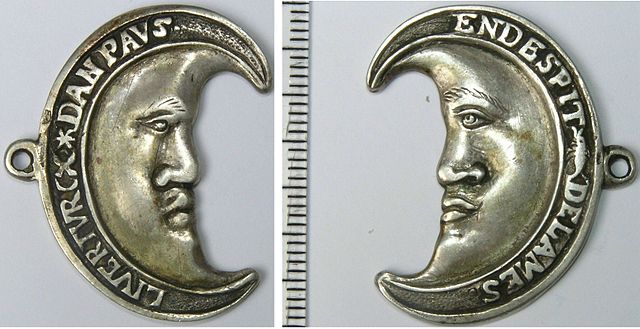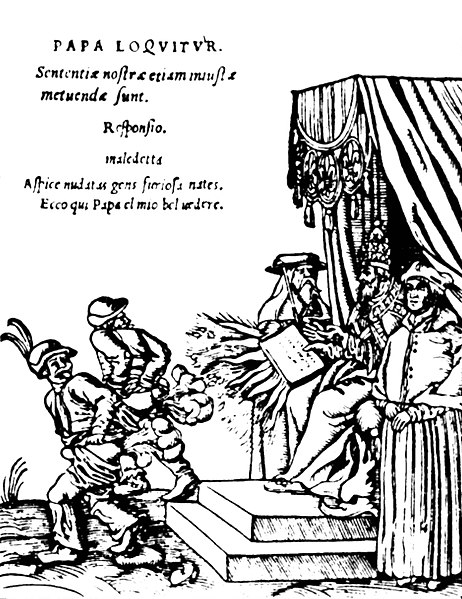The words Popery and Papism are mainly historical pejorative words in the English language for Roman Catholicism, once frequently used by Protestants and Eastern Orthodox Christians to label their Roman Catholic opponents, who differed from them in accepting the authority of the Pope over the Christian Church. The words were popularised during the English Reformation (1532–1559), when the Church of England broke away from the Roman Catholic Church and divisions emerged between those who rejected papal authority and those who continued to follow Rome. The words are recognised as pejorative; they have been in widespread use in Protestant writings until the mid-nineteenth century, including use in some laws that remain in force in the United Kingdom.
An 1807 satirical painting by James Gillray showing King George III of the United Kingdom saying "bring in the papists!"
A Dutch crescent-shaped Geuzen medal at the time of the anti-Spanish Dutch Revolt, with the slogan "Liever Turks dan Paaps" ("Rather Turkish than Papist"), 1570
St John the Baptist Church, Hagley, memorial to Meriel Lyttelton (a daughter of Thomas Bromley) from 1769, remembered "for Breeding up her Children in the Protestant Religion, Their Ancestors having been Papists"
Anti-Catholicism is hostility towards Catholics and opposition to the Catholic Church, its clergy, and its adherents. At various points after the Reformation, some majority-Protestant states, including England, Northern Ireland, Prussia, Scotland, and the United States, turned anti-Catholicism, opposition to the authority of Catholic clergy (anti-clericalism), opposition to the authority of the pope (anti-papalism), mockery of Catholic rituals, and opposition to Catholic adherents into major political themes and policies of religious discrimination and religious persecution. Major examples of groups that have targeted Catholics in recent history include Ulster loyalists in Northern Ireland during the Troubles and the second Ku Klux Klan in the United States. The anti-Catholic sentiment which resulted from this trend frequently led to religious discrimination against Catholic communities and individuals and it occasionally led to the religious persecution of them. Historian John Wolffe identifies four types of anti-Catholicism: constitutional-national, theological, popular and socio-cultural.

A famous 1876 editorial cartoon by Thomas Nast, an immigrant from Germany who had been raised as a Catholic. It portrays bishops as crocodiles who are attacking public schools, with the connivance of Irish Catholic politicians.
From a series of woodcuts (1545) usually referred to as the Papstspotbilder or Papstspottbilder, by Lucas Cranach, commissioned by Martin Luther. "Kissing the Pope's feet"; German peasants respond to a papal bull of Pope Paul III. Caption reads: "Don't frighten us Pope, with your ban, and don't be such a furious man. Otherwise we shall turn around and show you our rears".
Passional Christi und Antichristi, by Lucas Cranach the Elder, from Luther's 1521 Passionary of the Christ and Antichrist. The Pope as the Antichrist, signing and selling indulgences.
Foxe's Book of Martyrs glorified Protestant martyrs and shaped a lasting negative image of Catholicism in Britain.







